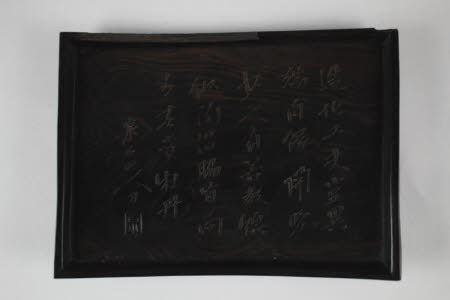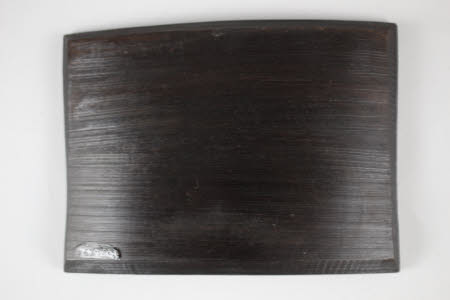Plaque
Hermit of Springs and Rocks (Quanshi Shanren)
Category
Wooden objects
Date
c. 1800 - c. 1910
Materials
Carved wood, lacquered on the reverse.
Measurements
45 x 38 x 21 cm
Place of origin
Jingdezhen
Order this imageCollection
Kedleston Hall, Derbyshire
NT 107642
Summary
Rectangular wooden plaque, carved with a poem by the Chinese scholar-official Han Pi (Northern Song period, died 1009), the carver identified with the pseudonym Hermit of Springs and Rocks, probably 19th or possibly early 20th century. Lacquered on the reverse.
Full description
The poem consists of four lines of seven characters each, divided into two couplets. It is written in semi-cursive script, starting in the top right-hand corner and moving from top to bottom, right to left. In regular characters (arranged from left to right, top to bottom) the poem reads: 造化工夫豈異端 自緣開晚少人看 若教總似陶潛眼 肯向芳春賞牡丹 Zaihua gongfu qi yiduan? Ziyuan kai wan shao ren kan. Ruo jiao zong si Tao Qian yan, Ken xiang fang chun shang mudan? It could be translated as: How can one call nature’s efforts wrong? Just because they flower late, fewer people look at them. But if everyone could see things the way Tao Qian does, Would they still enjoy peonies on a fragrant spring day? The poem is an oblique eulogy on the subtle beauty and sophistication of the late-flowering chrysanthemum, so indirect that it doesn’t actually name the flower. It relies instead on the educated Chinese reader’s familiarity with the life and work of the famous early poet Tao Qian (now more commonly called Tao Yuanming, 365–427), who renounced his official career, retreated to his country estate and devoted his time to writing poetry, drinking wine and growing chrysanthemums. Ever since, the chrysanthemum has been associated in East Asia with quiet introspection and modest sincerity, in contrast to the earlier-flowering, blowsy and colourful peony, which was seen as an expression of magnificence and sensuousness. Han Pi himself was from a humble background and gained success in the civil service examinations through his talent, but then struggled to rise through the official ranks. So this poem is actually a veiled expression of the poet’s frustration about his public career, as he felt bypassed and overlooked by the ‘peonies’ of this world. At the same time, it is also a celebration of the indirect ‘chrysanthemum’ aesthetic, in describing Han Pi’s feelings in the allusive language of flowers. The text on the plaque ends (i.e. on the left) with 泉石山人刀, Quanshi Shanren dao, ‘Carved by the Hermit of Springs and Rocks’, recording the pseudonym of the person who carved the poem into the plaque. This may have been a scholar-official, possibly someone who like Han Pi had experienced frustration or disappointment in his career and was ‘quoting’ the poem by inscribing it on a plaque. It would have been intended to be hung on a wall, as a sophisticated literary quote, an elegant sample of calligraphy, a skilful piece of carving, and possibly also as a personal biographical reference. (Emile de Bruijn, with grateful acknowledgement of the assistance of Luk Yu-ping and Xu Yixin, March 2022)
Provenance
Acquired by George Nathiel Curzon, Marquess Curzon of Kedleston (1859-1924); donated to the National Trust by Francis Curzon, 3rd Viscount Scarsdale (1924-2000), 1986.
Marks and inscriptions
End of text (left-hand side): 泉石山人刀, Quanshi Shanren dao, ‘Carved by the Hermit of Springs and Rocks’
Makers and roles
Hermit of Springs and Rocks (Quanshi Shanren), carver after Han Pi (d.1009), poet

